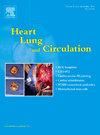Diabetes and Cardiometabolic Care, Pharmacotherapy, and Patient Outcomes in Two Regional Aboriginal Primary Care Health Centres: Lessons to be Learnt
IF 2.2
4区 医学
Q2 CARDIAC & CARDIOVASCULAR SYSTEMS
引用次数: 0
Abstract
Background
Type 2 diabetes mellitus (T2DM) affects Aboriginal Australian populations six times more frequently than non-Indigenous Australians, with disparity increasing by remoteness. Contemporary guidelines recommend optimising cardiometabolic care, including achieving a target glycated haemoglobin (HbA1c) <7%, blood pressure <130/80 mmHg, and use of pharmacotherapy, including the maximal tolerated statin dose and consideration of sodium–glucose co-transporter 2 inhibitors and glucagon-like peptide-1 receptor agonists in selected subpopulations.
Aim
This study aimed to determine whether cardiometabolic treatment targets and pharmacological management met best practice guidelines in two rural Aboriginal Community Controlled Health Organisations.
Method
A retrospective audit of electronic medical records was conducted in two rural Aboriginal Community Controlled Health Organisations between January 2020 and January 2021. Data were collected for people aged over 18 years who regularly attended the clinic, identified as Aboriginal, and had a documented diagnosis of T2DM.
Results
A total of 274 patients met the inclusion criteria, 64% of whom were female. The median age of T2DM diagnosis was 44 years (interquartile range 32–50), with a median diabetes duration of 9 years (3–17), HbA1c 8.0% (6.9–9.4), body mass index 31.6 kg/m2 (27–36.3), urine albumin–creatinine ratio (ACR) 3.8 mg/mol (1.1–20.0), and mean low density lipoprotein cholesterol 2.1 mmol/L (±0.8). Capture rates were 70% for HbA1c, 51% for urine ACR, and 51% for lipid studies. Among recorded results, 51/193 (26%) of HbA1c were <7%, 80/228 (35%) of blood pressure readings were below 130/80 mmHg. Nephropathy was present in 42% of patients, and obesity in 61%. Clinically significant albuminuria was observed in 69/140 (50%) of patients with available ACR data. Statins were prescribed in 50%, sodium–glucose co-transporter 2 inhibitors in 20%, and glucagon-like peptide-1 receptor agonists in 7% of the population.
Conclusions
This study has characterised a population with an early age of T2DM diagnosis, high rates of nephropathy and obesity, and suboptimal glycaemic control. Prescription rates of modern therapies were low. These findings highlight areas for targeted improvement in the quality of cardiometabolic care, including the increased use of modern diabetes agents.
两个地区土著初级保健中心的糖尿病和心脏代谢护理、药物治疗和患者结果:需要吸取的教训。
背景:2型糖尿病(T2DM)在澳大利亚土著人口中的发病率是非澳大利亚土著人口的6倍,随着偏远程度的增加,这种差异越来越大。当代指南建议优化心脏代谢护理,包括实现糖化血红蛋白(HbA1c)目标。目的:本研究旨在确定两个农村土著社区控制的卫生组织的心脏代谢治疗目标和药理管理是否符合最佳实践指南。方法:在2020年1月至2021年1月期间对两个农村土著社区控制的卫生组织的电子病历进行回顾性审计。数据收集年龄在18岁以上,定期到诊所就诊,被确定为原住民,并被诊断为T2DM的人。结果:274例患者符合纳入标准,其中女性占64%。T2DM诊断的中位年龄为44岁(四分位数范围32-50),中位糖尿病病程为9年(3-17),HbA1c为8.0%(6.9-9.4),体重指数为31.6 kg/m2(27-36.3),尿白蛋白-肌酐比(ACR)为3.8 mg/mol(1.1-20.0),平均低密度脂蛋白胆固醇为2.1 mmol/L(±0.8)。HbA1c捕获率为70%,尿ACR捕获率为51%,脂质捕获率为51%。在记录的结果中,51/193(26%)的HbA1c是T2DM的早期诊断人群,肾病和肥胖率高,血糖控制不佳。现代疗法的处方率很低。这些发现强调了有针对性地改善心脏代谢护理质量的领域,包括增加现代糖尿病药物的使用。
本文章由计算机程序翻译,如有差异,请以英文原文为准。
求助全文
约1分钟内获得全文
求助全文
来源期刊

Heart, Lung and Circulation
CARDIAC & CARDIOVASCULAR SYSTEMS-
CiteScore
4.50
自引率
3.80%
发文量
912
审稿时长
11.9 weeks
期刊介绍:
Heart, Lung and Circulation publishes articles integrating clinical and research activities in the fields of basic cardiovascular science, clinical cardiology and cardiac surgery, with a focus on emerging issues in cardiovascular disease. The journal promotes multidisciplinary dialogue between cardiologists, cardiothoracic surgeons, cardio-pulmonary physicians and cardiovascular scientists.
 求助内容:
求助内容: 应助结果提醒方式:
应助结果提醒方式:


